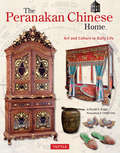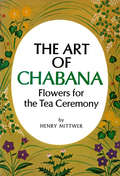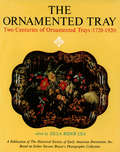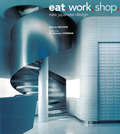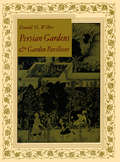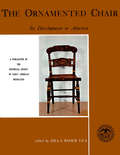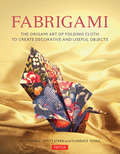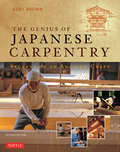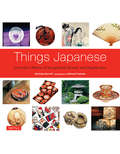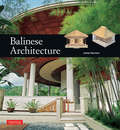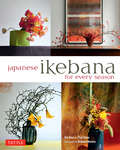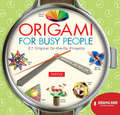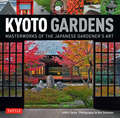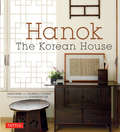- Table View
- List View
The Peranakan Chinese Home
by A. Chester Ong Ronald G. KnappDiscover the rarified Peranakan (native-born Chinese of Southeast Asia) aesthetics that are today highly sought-after for their beauty: distinctive furniture and ceramics, textiles and jewelry, and many other art objects. Peranakan Chinese Home displays these extraordinary objects, visible markers of a highly developed culture.The broad range of beautiful objects which the Peranakan Chinese created and enjoyed in their daily lives is astounding. Each chapter in Peranakan Chinese Home focuses on a different area and presents objects used or found in those spaces. Each piece is described in the context of their utility as household objects, as part of periodic celebrations to mark the Chinese New Year and other holidays, or in important life passage rituals relating to ancestor worship, birth, marriage, mourning and burial. The meaning of the rich symbolic and ornamental motifs found on the objects is discussed in detail and key differences are highlighted between Peranakan objects and similar ones found in China.A fascinating mix of Chinese, European and Southeast Asian influences, the distinctly Peranakan identity of a people and their culture is beautifully portrayed through objects and archival photographs in this lovely and exotic book.
The Peranakan Chinese Home
by A. Chester Ong Ronald G. KnappDiscover the rarified Peranakan (native-born Chinese of Southeast Asia) aesthetics that are today highly sought-after for their beauty: distinctive furniture and ceramics, textiles and jewelry, and many other art objects. Peranakan Chinese Home displays these extraordinary objects, visible markers of a highly developed culture.The broad range of beautiful objects which the Peranakan Chinese created and enjoyed in their daily lives is astounding. Each chapter in Peranakan Chinese Home focuses on a different area and presents objects used or found in those spaces. Each piece is described in the context of their utility as household objects, as part of periodic celebrations to mark the Chinese New Year and other holidays, or in important life passage rituals relating to ancestor worship, birth, marriage, mourning and burial. The meaning of the rich symbolic and ornamental motifs found on the objects is discussed in detail and key differences are highlighted between Peranakan objects and similar ones found in China.A fascinating mix of Chinese, European and Southeast Asian influences, the distinctly Peranakan identity of a people and their culture is beautifully portrayed through objects and archival photographs in this lovely and exotic book.
The Peranakan Chinese Home
by Ronald G. Knapp A. Chester OngDiscover the rarified Peranakan (native-born Chinese of Southeast Asia) aesthetics that are today highly sought-after for their beauty: distinctive furniture and ceramics, textiles and jewelry, and many other art objects. Peranakan Chinese Home displays these extraordinary objects, visible markers of a highly developed culture.The broad range of beautiful objects which the Peranakan Chinese created and enjoyed in their daily lives is astounding. Each chapter in Peranakan Chinese Home focuses on a different area and presents objects used or found in those spaces. Each piece is described in the context of their utility as household objects, as part of periodic celebrations to mark the Chinese New Year and other holidays, or in important life passage rituals relating to ancestor worship, birth, marriage, mourning and burial. The meaning of the rich symbolic and ornamental motifs found on the objects is discussed in detail and key differences are highlighted between Peranakan objects and similar ones found in China.A fascinating mix of Chinese, European and Southeast Asian influences, the distinctly Peranakan identity of a people and their culture is beautifully portrayed through objects and archival photographs in this lovely and exotic book.
Quiet Beauty
by Kendall H. Brown David M. CobbQuiet Beauty: Japanese Gardens of North America is an extraordinary look at the most beautiful-and serene-gardens in the United States and Canada. Most Japanese garden books look to the gardens of Japan. Quiet Beauty explores the treasure trove of Japanese gardens located in North America. Featuring an intimate look at twenty-six gardens, with numerous stunning color photographs of each, that detail their style, history, and special functions, this book explores the ingenuity and range of Japanese landscaping.Gardens include: Japanese Tea Garden in Golden Gate Park, San Francisco, California Nitobe Memorial Garden, University of British Columbia, Vancouver, British Columbia Japanese Garden, Fort Worth Botanic Garden, Texas Garden of the Pine Winds, Denver Botanic Gardena, Colorado Japanese Garden, Montréal Botanical Garden, Québec Tenshin'en (The Garden of the Heart of Heaven), Museum of Fine Arts, Boston, Massachusetts Roji'en (Garden of Drops of Dew), The George D. and Harriet W. Cornell Japanese Gardens, The Morikami Museum and Japanese Gardens, Delray Beach, Florida Japanese Friendship Garden of Phoenix, Margaret T. Hance Park, Arizona Garden of the Pine Wind, Garven Woodland Garden, Hot Springs, Arkansas
Quiet Beauty
by Kendall H. Brown David M. CobbQuiet Beauty: Japanese Gardens of North America is an extraordinary look at the most beautiful-and serene-gardens in the United States and Canada. Most Japanese garden books look to the gardens of Japan. Quiet Beauty explores the treasure trove of Japanese gardens located in North America. Featuring an intimate look at twenty-six gardens, with numerous stunning color photographs of each, that detail their style, history, and special functions, this book explores the ingenuity and range of Japanese landscaping.Gardens include: Japanese Tea Garden in Golden Gate Park, San Francisco, California Nitobe Memorial Garden, University of British Columbia, Vancouver, British Columbia Japanese Garden, Fort Worth Botanic Garden, Texas Garden of the Pine Winds, Denver Botanic Gardena, Colorado Japanese Garden, Montréal Botanical Garden, Québec Tenshin'en (The Garden of the Heart of Heaven), Museum of Fine Arts, Boston, Massachusetts Roji'en (Garden of Drops of Dew), The George D. and Harriet W. Cornell Japanese Gardens, The Morikami Museum and Japanese Gardens, Delray Beach, Florida Japanese Friendship Garden of Phoenix, Margaret T. Hance Park, Arizona Garden of the Pine Wind, Garven Woodland Garden, Hot Springs, Arkansas
The Art of Chabana
by Henry MittwerChabana is a simple arrangement of floral or other plant material traditionally placed in the tokonoma, or alcove, of the room in which the tea ceremony is performed. There are no rules in arranging Chabana, the author tells us, no specail measurements or geometric patterns, Rather, the creator of a Chabana must use his imagination and, most of all, a special inspiration from within. The author does give some practical guidelines, however, on the minutiae of arranging a Chabana. And he discusses in length more than 100 flowers that are suitable for Chabana, explaining exactly how they can be used and the most appropriate seasons for their display. The book includes a complete list of plants with names in English, Japanese, and Latin.
The Ornamented Tray: Two Centuries of Ornamented Trays (1720-1920)
by W. D. John Zilla Rider LeaThis authoritative and definitive work contains the first formal history of antique trays every published. Each of its six chapters is written by a different authority. <P><P>They discuss:Lace-Edge PaintingThe "Chippendale" StyleTrays Ornamented with Gold LeafThe Freehand Bronze TechniquesStenciled TraysThe Country Painted TrayThe book is lavishly illustrated with more than 500 photographs, seven of them in full color, including pictures of trays prized by museums and private collectors, as well as hundreds selected from the unique photographic collection of the late Esther Stevens Brazer.
Eat. Work. Shop
by Marcia Iwatate Terence ConranEat. Work. Shop. presents a striking collection of cutting-edge commercial sites in Japan.Vibrant color photography and compelling text make this the ultimate guide to modern Japanese life. Seven of the country's foremost architects showcase their ideas in 34 shops, restaurants, salons, bars and spas. The architecture and interior designs are uniquely Japanese and will add a distinctive flair to any retail, office or retail design project. In collaboration with a new generation of entrepreneurs, these designers are reshaping basic concepts of how contemporary Japanese eat, work and shop. Beautifully illustrated with over 250 photos, the locations in this book reflect everything from postmodern industrialism to suggestive eroticism. A whole new language of design, propelled by the Japanese penchants for innovation, has given this generation a carte blanche to redefine Japan as the world's next cultural superpower, unhindered by the barriers of tradition.
Persian Gardens & Garden Pavilions
by Donald N. WilberThis Persian gardening book showcases classic gardens and pavilions and presents gardening advice for the aspiring amateur landscaper looking to add an Eastern flair to his or her yard.The garden has always had a special meaning for Persian (Iran). <P><P>The Persian garden, with its flowing pools, fountains, waterways, rows of tall trees, rich arrays of fruit trees and flowers, and cool pavilions, has represented an image of paradise.Persian Gardens & Garden Pavilions is both a comprehensive survey and an appreciation of this Persian tradition of gardens and garden pavilions. The text traces the historical development of Persian gardens, describes their basic features, presents existing examples, and discusses the literature and tradition behind them. The 119 illustrations include detailed plans and photographs of surviving gardens and their pavilions made on the spot, as well as a comprehensive collection of paintings, lithographs, and drawings of the nineteenth century executed both by Persian artists and by European travelers and emissaries of the period.The author points out, the gardeners who read this book should come across many details and ideas that can be incorporated into their own kinds of gardens.
Consider the Lilies
by Alfreda Oko Martin Edward MartinJapanese flower arranging has attracted a world wide following, and this book is a simple and clear introduction to the art.The first section illustrates thirty-six suggested flower arrangements with diagrams and full how-to-do-it instructions. The second part of the book explains the theory and technique of Japanese flower arrangement. The result is a book which gives an astonishing range of flower arrangements, clear explanations of how to make them at home, and an inspiring selection of devotional passages.
The Ornamented Chair
by Zilla Rider LeaDiscriminating decorators and collectors, no less than dealers and researchers in antiques, have long felt the need of a comprehensive study of the ornamented chair and its development in America. This book is the product of an effort to satisfy that need and at the same time to bring new pleasures to lovers of beautiful furniture.The book is based on photographic and research material collected by the late Esther Stevens Brazer, who spent a lifetime in the study and revival of early American decoration.The authors are all qualified researchers, teachers, and decorators. In their text they present a general history of chair types, facts regarding ornamentation, and informative accounts of some of the leading craftsmen and decorators of the various periods. The final chapter of the book briefly relates the history of the Society and describes how its members carry forward the efforts of Esther Stevens Brazer, maintaining in their research, their teaching, and their restorations the standards of an old craft and the traditions of its finest workmen.
The Ornamented Chair
by Zilla Rider LeaDiscriminating decorators and collectors, no less than dealers and researchers in antiques, have long felt the need of a comprehensive study of the ornamented chair and its development in America. This book is the product of an effort to satisfy that need and at the same time to bring new pleasures to lovers of beautiful furniture.The book is based on photographic and research material collected by the late Esther Stevens Brazer, who spent a lifetime in the study and revival of early American decoration.The authors are all qualified researchers, teachers, and decorators. In their text they present a general history of chair types, facts regarding ornamentation, and informative accounts of some of the leading craftsmen and decorators of the various periods. The final chapter of the book briefly relates the history of the Society and describes how its members carry forward the efforts of Esther Stevens Brazer, maintaining in their research, their teaching, and their restorations the standards of an old craft and the traditions of its finest workmen.
Fabrigami
by Florence Temko Scott Wasserman Stern Jill StovallFabrigami is the art of folding fabrics to create three-dimensional objects ranging from the practical to the whimsical. Like paper, there are countless beautiful fabric designs to choose from, only fabric has the virtue of being extremely durable.Fabrigami began as origami legend Florence Temko's final project. Everyone knows that origami is the art of paper folding, but Temko had begun experimenting with folding fabric to make objects that are just as beautiful but more lasting than paper. Sadly, Temko passed away before the book was completed, but her collaborator, Jill Stovall, continued their work. Now, Stovall-with the help of Scott Stern, a rising young star of origami-brings Fabrigami to print for everyone to use and enjoy.This book begins by presenting instructions on how to treat fabric so it holds a shape when folded. Then Stovall shares a series of fun craft projects with simple origami-style diagrams that you can use to make a range of lovely objects, including: Fan-tastic Fold Earrings Evening Wine Coat Florence's Hexagon Box Cloth Kimono Card Pleated Peacock
The Genius of Japanese Carpentry
by Azby BrownThis new edition of this Azby Brown architecural classic contains a new preface by Brown, fully revised chapters, along 25% new photography and in color for the first time.An extraordinary and ambitious work of architectural reconstruction is underway in twenty-first century Nara. The Genius of Japanese Carpentry is the story of the twelve-hundred-year-old Yakushiji monastery and the dedicated modern-day craftsmen who are working to restore what has been lost to the depredations of time, fire, and warfare.In the eighth century, anonymous carpenters first erected the intricately-designed timber temples and pagodas that compose the Yakushiji Buddhist monastery. Then as today, these buildings were considered marvels of architectural elegance and traditional Japanese craftsmanship. Although the full restoration will not be complete until 2030, one of the main temples, the Picture Hall, has been completely reconstructed, employing the original methods, architectural style, and largely the same woodworking technology as its predecessors. Azby Brown chronicles the Picture Hall's painstaking restoration through photographs, extensive interviews with the carpenters and woodworkers, and original drawings based on the plans of Japanese master carpenter Tsunekazu Nishioka. An inspiring testament to the craftsmen, their dedication to excellence, and their philosophy of work as personal fulfillment, The Genius of Japanese Carpentry offers detailed documentation of this singular project and a moving reminder of the humanity that bridges past and present.
Things Japanese
by Nicholas BornoffBeautifully crafted samurai swords; exquisitely carved netsuke toggles; elegant wooden tansu chests; elaborate tea ceremony implements; fabulously expensive silk-and-gold embroidered kimonos. All of these highly recognizable Japanese objects are imbued with a sense of history and artistry, as well as a unique Japanese aesthetic sense that easily reaches across cultural boundaries. In Things Japanese: Everyday Objects of Extraordinary Beauty and Significance, author Nicholas Bornoff and photographer Michael Freeman examine over 60 traditional objects that are definitively, uniquely Japanese, demonstrating their significance and relevance for a modern Western audience. In this delightful book, each object is shown and described in loving detail-placed within its broader historical and cultural context as an everyday item used by real people in traditional Japan. Each item is listed under its Japanese and English name-and illustrated in glorious, full-color photographs to highlight its great artistry and craftsmanship. Things Japanese is the perfect book for the antique lover in your life, or anyone interested in the art, culture and history of Japan.
Things Japanese
by Michael Freeman Nicholas BornoffBeautifully crafted samurai swords; exquisitely carved netsuke toggles; elegant wooden tansu chests; elaborate tea ceremony implements; fabulously expensive silk-and-gold embroidered kimonos. All of these highly recognizable Japanese objects are imbued with a sense of history and artistry, as well as a unique Japanese aesthetic sense that easily reaches across cultural boundaries. In Things Japanese: Everyday Objects of Extraordinary Beauty and Significance, author Nicholas Bornoff and photographer Michael Freeman examine over 60 traditional objects that are definitively, uniquely Japanese, demonstrating their significance and relevance for a modern Western audience.In this delightful book, each object is shown and described in loving detail-placed within its broader historical and cultural context as an everyday item used by real people in traditional Japan. Each item is listed under its Japanese and English name-and illustrated in glorious, full-color photographs to highlight its great artistry and craftsmanship. Things Japanese is the perfect book for the antique lover in your life, or anyone interested in the art, culture and history of Japan.
Balinese Architecture
by Luca Invernizzi Tettoni Bruce Granquist Davison Julian Nengah Enu Mubinas HanafiBalinese style villas and resorts are popping up everywhere-from Ibiza to St Barts to Singapore. But what is Balinese architecture? And why is it so popular today?Traditional Balinese houses, temples and pavilions are designed to allow man to exist in harmony with the natural forces of the universe-reflecting core Balinese beliefs about man's place in relation to the cosmos, the gods, the ancestors, and the world around him. Innovative local and Western architects have been designing resorts and villas on Bali for decades, drawing their inspiration from these local traditions.In this one-of-a-kind book, author Julian Davison provides a comprehensive guide to Balinese architectural forms, the Balinese belief system, the rituals associated with building, the materials and construction techniques, and the intricate ornamentation used. Over 100 watercolor illustrations and photographs provide a clear picture of the island's architecture as well as an eye-opening look at a culture and a people that have captivated the world's imagination.
Japanese Ikebana for Every Season
by Noboru Murata Yuji Ueno Rie ImaiThe true meaning of Ikebana-the traditional Japanese art of flower arrangement-is the ability to take a few beautiful flowers and plans and tastefully present them in very simple containers to decorate your home. Whether for Mother's Day, Valentine's Day, or a special birthday or anniversary-Japanese Ikebana for Every Season simplifies and demystifies this ancient art by presenting 53 elegantly simple arrangements that anyone can create at anytime at home.The key to good Ikebana arrangements is to understand a few very simple principles-like the idea of mitate-seeing old things with new eyes, as well as learning a few very easy techniques of flower stabilization and how to support plants and flowers inside a vase or container. Using simple, common flowers and plants from your garden, from a nearby field or forest, or from your local florist-you can easily create these lovely Ikebana in just a few minutes if you know how.Authors Rie Imai and Yuji Ueno explain how to select the flowers and the containers by simply using things that are already around you-and then they show you how to turn them into something special. The basic instructions in the book cover a wide range of styles that encourage readers to use their own creativity rather than copying traditional and highly technical Ikebana design concepts.No matter what time of year it is and regardless of your taste or budget-the arrangements in this book will lend a touch of Japanese elegance to your home!
Origami for Busy People
by Marcia Joy MillerTurn a crazy, hectic work day around in just a few minutes with Origami for Busy People. Before jumping from one project to another, a little mental relaxation comes in handy to rejuvenate and revive the brain. This fun little book provides a variety of shorter and longer projects that can be completed during a coffee break, over lunch, or whenever a mini vacation is required.Projects include: Duck Glider Ghost Trigon Reversible StarSpring Flower Fluted Vase Starry SkyBasic folding techniques, color photos of the 27 projects and 48 tear-out folding sheets combine to make this handy book a new workplace favorite!
Kyoto Gardens
by Ben Simmons Judith ClancyKyoto Gardens is a labor of love from master photographer Ben Simmons and Kyoto-based writer Judith Clancy. Simmons' photographs present a fresh and contemporary look at Kyoto's most important gardens. Their beauty is enhanced and humanized by gardeners tending the grounds using the tools of their art. Clancy's graceful text provides historic, aesthetic and cultural context to the gardens. Combining wonder and rigor, she describes how Kyoto's most beloved gardens remain faithful to their founders' creative spirit and conception. Journey to Kyoto's thirty gardens with just a turn of a page, or use the handy maps to plan your trip.
Kyoto Gardens
by Judith ClancyKyoto Gardens is a labor of love from master photographer Ben Simmons and Kyoto-based writer Judith Clancy. Simmons' photographs present a fresh and contemporary look at Kyoto's most important gardens. Their beauty is enhanced and humanized by gardeners tending the grounds using the tools of their art. Clancy's graceful text provides historic, aesthetic and cultural context to the gardens. Combining wonder and rigor, she describes how Kyoto's most beloved gardens remain faithful to their founders' creative spirit and conception. Journey to Kyoto's thirty gardens with just a turn of a page, or use the handy maps to plan your trip.
Kyoto Gardens
by Judith ClancyKyoto Gardens is a labor of love from master photographer Ben Simmons and Kyoto-based writer Judith Clancy. Simmons' photographs present a fresh and contemporary look at Kyoto's most important gardens. Their beauty is enhanced and humanized by gardeners tending the grounds using the tools of their art. Clancy's graceful text provides historic, aesthetic and cultural context to the gardens. Combining wonder and rigor, she describes how Kyoto's most beloved gardens remain faithful to their founders' creative spirit and conception. Journey to Kyoto's thirty gardens with just a turn of a page, or use the handy maps to plan your trip.
Hanok: The Korean House
by Nani Park Jongkeun Lee Robert J. FouserIn recent decades, few nations have transformed themselves as radically as Korea. Amid Seoul's glass-and-steel skyscrapers and luxury apartments, however, the traditional Korean home or Hanok is experiencing a surprising renaissance. Hanok: The Korean House showcases twelve very special Hanok that reflect today's Korea-a country that's putting a modern twist on traditional values. While the exteriors of these houses are indistinguishable from Hanok built decades ago, the interior designs have been completely updated.Traditional materials of stone, wood, and clay are still the only components used in these houses. They also incorporate natural elements such as wind and sunlight, and baesanimsu-known in Chinese as feng shui-used to position the Hanok in harmony with the natural forces and geographical features of the site. But many of these new Hanok owners are architects who have incorporated open floor plans and cutting-edge architectural elements to create a more functional home.
Hanok: The Korean House
by Nani Park Robert J. Fou serIn recent decades, few nations have transformed themselves as radically as Korea. Amid Seoul's glass-and-steel skyscrapers and luxury apartments, however, the traditional Korean home or Hanok is experiencing a surprising renaissance. Hanok: The Korean House showcases twelve very special Hanok that reflect today's Korea-a country that's putting a modern twist on traditional values. While the exteriors of these houses are indistinguishable from Hanok built decades ago, the interior designs have been completely updated. Traditional materials of stone, wood, and clay are still the only components used in these houses. They also incorporate natural elements such as wind and sunlight, and baesanimsu-known in Chinese as feng shui-used to position the Hanok in harmony with the natural forces and geographical features of the site. But many of these new Hanok owners are architects who have incorporated open floor plans and cutting-edge architectural elements to create a more functional home.
Sustainable Luxury
by Paul Mcgillick Masano KawanaSingapore is celebrated as one of the most livable cities in Asia, and Sustainable Luxury shows how the prosperous, forward-looking nation is pioneering innovative solutions for environmental, economic, social, and cultural issues faced the world over. Dr. Paul McGillick, the author of The Sustainable Asian House (Tuttle, 2013), presents twenty-seven recent residential projects created by Singapore's most talented architects to address the many complex and interconnected aspects of sustainability.Some of the homes featured here emphasize environmental needs, while others are concerned with preserving cultural traditions or supporting societal and interpersonal needs-such as extended family dwellings. Each residence, however, exhibits solutions developed from a holistic point of view. These homes typically embrace the tropical climate rather than fight it, and illustrate how smart manipulation of air flows, light, shade, water, and landscaping sustain higher levels of comfort without resorting to air-conditioning.In addition to profiling individual residences, Sustainable Luxury looks at the big picture, canvassing the most pressing issues-including changing demographics and lifestyles-and examining the available solutions. Anyone concerned with the future of our world will be fascinated by the houses presented here and the ways in which Singapore is leading the way in the development of residential architecture that is as luxurious as it is sustainable.
